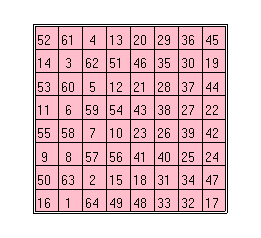Older links
- (4/3): We saw a presentation on the Golden Spiral and built our own approximations. We also learned that the Golden Spiral has appeared (both deliberately and accidentally) in art for a long time! For some examples, see this link.
- Here is the paper I referenced about knight tours. And here is a slide presentation that gives a perhaps more intuitive explanation for some of the results.
- 2/27: We saw a presentation on "Math Beyond Infinity" today, and discussed different "sizes" of infinity.
Check out
Hilbert's Hotel for an intuition-building follow-up.
(Tip: as mentioned in class, this would be a very good in-class presentation for someone,
so if you're looking for ideas, check this out!)
You could also start by looking at this short video: - Here is a step-by-step write-up of the Ken-Ken creation tutorial we went through in class on 2/27. It might be helpful as you think about how to create your own puzzles!
- 2/25: We learned a bit in today's presentation about the history of the number system we use today!
If you'd like to know more, the
Wikipedia entry is a good place to start.

- 2/20: Here is a follow-up
to the presentation we saw in class about Benjamin Franklin's (semi)magic squares which includes a bit of background
about how he constructed them. Complete with a diss at recreational mathematicians!
"Being one day in the country at the house of our common friend, the late learned Mr. Logan, he showed me a folio French book filled with magic squares, wrote, if I forget not, by one M. Frenicle [Bernard Frenicle de Bessy], in which, he said, the author had discovered great ingenuity and dexterity in the management of numbers; and, though several other foreigners had distinguished themselves in the same way, he did not recollect that any one Englishman had done anything of the kind remarkable. I said it was perhaps a mark of the good sense of our English mathematicians that they would not spend their time in things that were merely 'difficiles nugae', incapable of any useful application."
Click on this picture to see a colorful version of the page that was passed around in class, and stare at this animation for a little while.
-- Benjamin Franklin, The Autobiography of Benjamin Franklin
- 2/18: We saw a presentation about Leage of Legends and the role that linear optimization plays in determining how to spend one's resources.
- Here is a very nice write-up that gives some intuition into how to think about puzzles like the Liar & Truth-teller. This also applies to a large number of logic problems, and is in general a good introduction to a more logical mode of thinking.
- 2/11: We had a presentation and discussion on the backdoor that the NSA may have put into RSA's cryptography. Here is an article that gives a sort of primer on the technical aspects of what that means and how it works. No advance knowledge of cryptography is required.
- 2/4: Here's a nice follow-up video to what we saw in the
class presentation of the
Twelve Tone Series.
- 1/30: We saw a really cool presentation on the Missing Square Puzzle. Check out
the Wikipedia article
for a few other examples. My personal favorite:

- 1/21: We saw a presentation on the golden ratio, which appears all over math as well as in nature. Here is a page that has an applet you can use to draw nice patterns, and which describes how the golden ratio relates to sunflowers (as mentioned in class).
- 1/16: Here is the full solution to the puzzle discussed in class about evening out marbles, which gives the full explanation for why the process terminates. Check out the CMU shout-out in the solutions! (source: Mathematical Mind-Benders by P. Winkler)